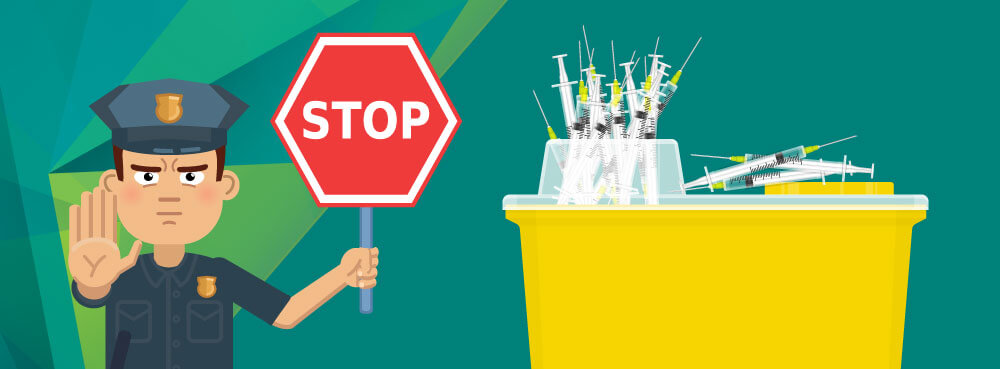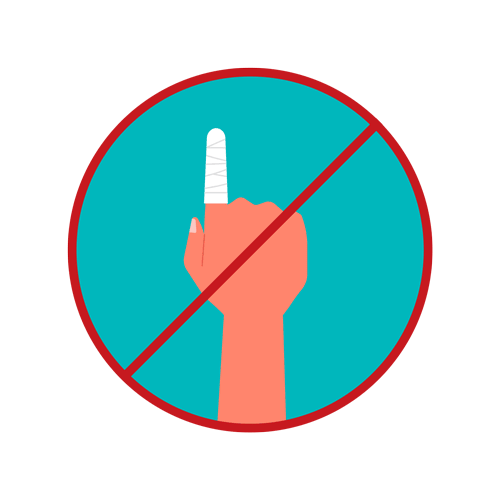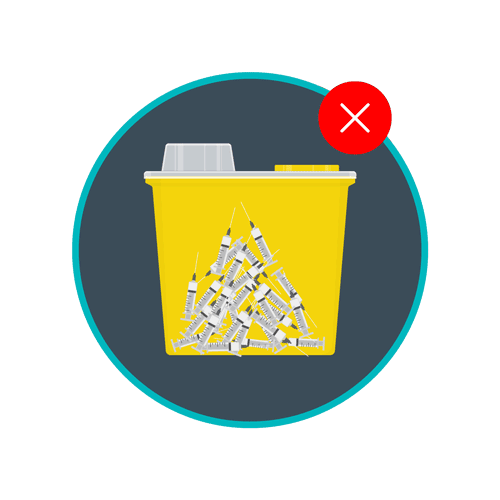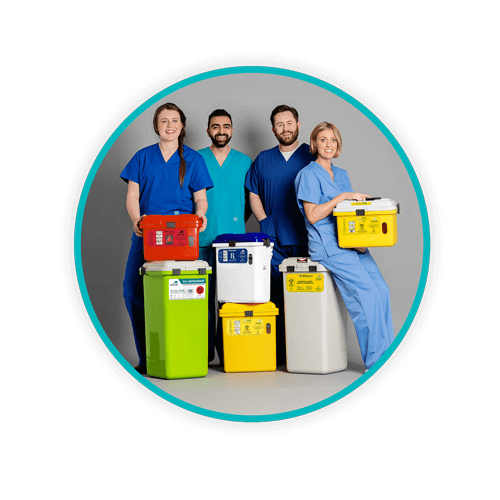How to Eliminate Sharps Containers Overfilling

“Sharps” is a term used within the medical community to describe pointed or sharp objects like needles (hypodermic syringes), scalpels, lancets, and razor blades. Basically, it’s any object that could cause an injury to the staff from a puncture or cut injury.
Instances of needlestick injuries (NSIs) can create health risks and the transmission of bloodborne diseases (BBDs). These can include human immunodeficiency viruses and hepatitis B and C from a patient to the medical staff. Improving the use and compliance of sharps bin containers can significantly decrease and prevent exposure to NSIs and the potential for transmission of BBDs.
Here in Canada medical facilities are required to use safe sharps storage devices. These can include devices that have built-in safeguards to protect medical staff from coming in contact with a contaminated sharp. In a busy healthcare environment, sharps collection containers can fill up quickly. And when containers overflow, it can increase the risk of injury. That’s why it’s essential to minimise the times when sharps containers overflow.
TOPICS WE WILL COVER:
1 / What are the safety benefits of sharps containers?
2 / How much of a problem is overfilling containers?
3 / The high cost of sharps injuries
4 / What are some solutions to overfilling containers?
5 / A sharps container designed to prevent premature overfill
6 / Learn more about the Sharpsmart
What are the Safety Benefits of Sharps Containers?
In Canada, sharps containers need to meet certain safety requirements to ensure they protect both staff and patients. Any device that contains contaminated sharps has to be resistant to puncture. The bottom and sides must also be leakproof. They must be colour-coded and clearly labelled to warn the staff that the contents of the container may be dangerous.
Sharps storage containers have to be fully closable. They must have a door, lid, or flap as a means of closing and sealing the waste inside. Containers must be stored upright to ensure that liquids cannot spill or leak out.
All sharps containers should be replaced on a regular basis and never overfilled. Containers that are overfilled can increase the risk of exposure to pathogens to the staff from cuts or needlesticks. Any sharps containers that are reusable should never be opened and emptied or manually cleaned in any way that could expose staff to any risk of a sharps injury.
Medical facilities must also ensure that contaminated reusable sharps are stored and processed in a unit which prevents anyone from being able to reach into the container.
In Canada, how much of a problem is overfilling containers?
In Canada, historical data shows that as many as 69,000 annual injuries can come from sharps. Health Canada reported that 41% of all needlestick injuries occur during use and 45% happen post-use.
The Ontario Medical Association estimated that medical staff injured from a sharp that was contaminated by the hepatitis B virus had a 6 to 30% chance of being infected. In regard to hepatitis C and HIV, there is a 1.8% and 0.3% chance, respectively, for contracting disease if a staff member suffered from a sharps injury.
Because hepatitis B can survive outside of the body for over a week, exposure can still occur if staff come in contact with inanimate objects in the environment. Sharps injuries have transmitted several diseases to injured medical personnel. Some of the more serious diseases transmitted in this way include diphtheria, cutaneous gonorrhoea, herpes, malaria, staphylococcus, streptococcus, syphilis and tuberculosis. Most of these have occurred as isolated events, but it clearly demonstrates the importance of device storage and disposal safety and the serious consequences that can occur from injuries from needlestick or sharps.
The High Cost of Sharp Injuries
The cost of a single sharp or needlestick injury can range from $640 (CAD) to $5,100. This does not take into account long-term treatment from an illness caused by a sharps injury or litigation and compensation costs. There is also follow-up testing, disability, and lost time from work costs. Leveraging all these costs, it’s estimated that the annual financial burden to the healthcare industry is between $151 million to $757 million.
What are some solutions to overfilling containers?
Although healthcare settings will always be producing sharps waste, there are solutions to the problem of overfilling. Daniels Health has developed a sharps container that maximises the sharps container space. These waste containment systems have set the standard for hospital waste management.
Traditional sharps containers typically use a funnel design. Sharps enter the container vertically and they stack up in the container. Overfill can occur quite quickly as a pyramid effect occurs where lots of gaps exist within the containers as sharps haphazardly pile up. The Sharpsmart design flips this concept on its head. Instead of vertical disposal, Sharpsmart is designed to stack sharps in a neat, horizontal pile. This eliminates significant amounts of wasted space within the container, cutting down on the time and cost of having to swap out filled containers. A weighted tray allows sharps to be safely placed for disposal. Then they are horizontally secured within the container, keeping them neatly stacked and saving space.
Sharpsmart is designed to be more efficient and to lessen container overfill, saving health care facilities on the cost of filled sharps containers.
A Sharps Container Designed to Prevent Premature Overfill
The reuseable Sharpsmart sharps container is supported by patented robotic cleaning technology that reaches the highest levels of microbial decontamination. Our container has multiple safety features in place to keep medical staff out of harm’s way at all times. These include:
- A gravity balanced safety tray. We designed the safety tray to restrict hand access. Sharps are released away from the user and into the collection container. This removes any risk of rollbacks or bouncing of sharps.
- Constructed of maximum–strength hardened plastic. This material makes the container’s interior impenetrable by sharps. A single Sharpsmart can undergo 500 wash cycles, and to date it is the only sharps container in Canada that has not had a single FDA incident of needle penetration in the container.
- Content levels. A clear view window in the container shows the fill level of the unit without showing any of its contents.
- Locking mechanism. The temporary locking closure ensures safety for collectors if the unit has to be moved or transported.
- Wide opening. The Sharpsmart container has the largest deposition area in the industry. This allows ease of the disposal of sharps. It also has a content protection shield to guard against any injuries from needlesticks.
- It eliminates overfilling. The tray defaults to a locked upright position when the contents reach their maximum fill capacity. This eliminates the associated risks of overfilling.
- No leak seal. The lid of the container has been engineered to seal, eliminating any leakage of the contents during transport.
-
Tamper proof. The Sharpsmart container has permanent side locks to prevent the unit from being opened once it’s full. This eliminates tampering or unauthorised access to its contents.
Learn More about the Sharpsmart
The Sharpsmart is the first reusable waste containment system that actively protects medical staff from sharps and needlestick injuries. This not only prevents the risk of injury and infection, but also reduces the environmental burden of sharps waste, ensuring every container fully utilises the space inside. The Sharpsmart container has been recognised in medical journals as the safest sharps container in the world.
If you’d like to learn more about what Daniels Health can do to help keep your medical staff safe, visit our website today and request a free proposal.
